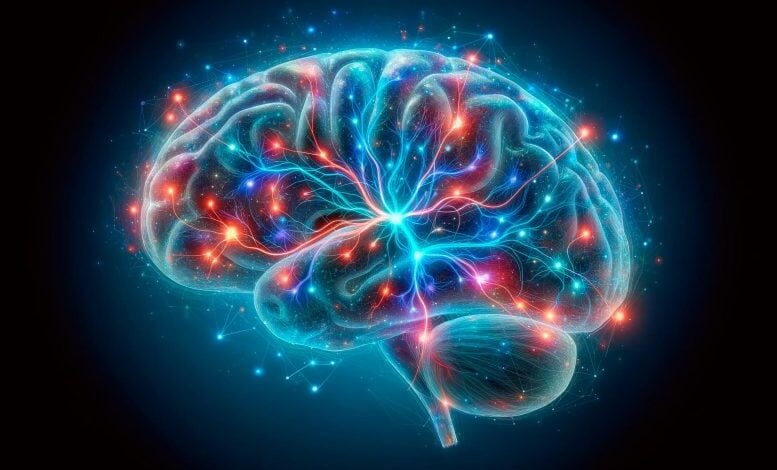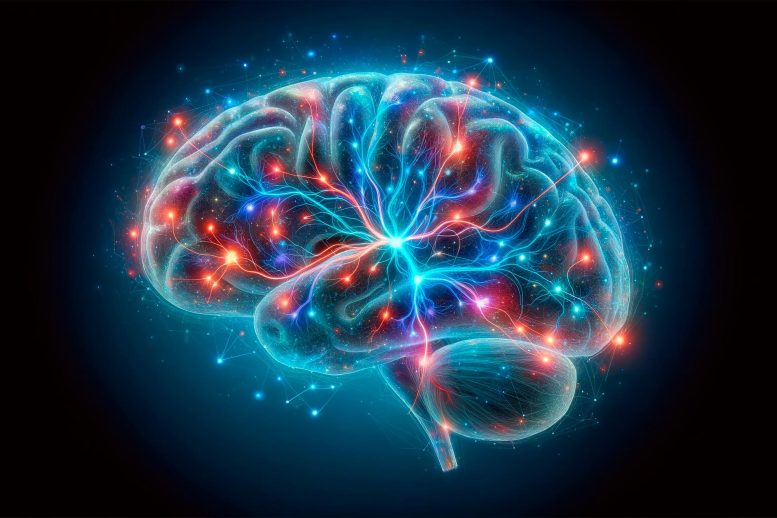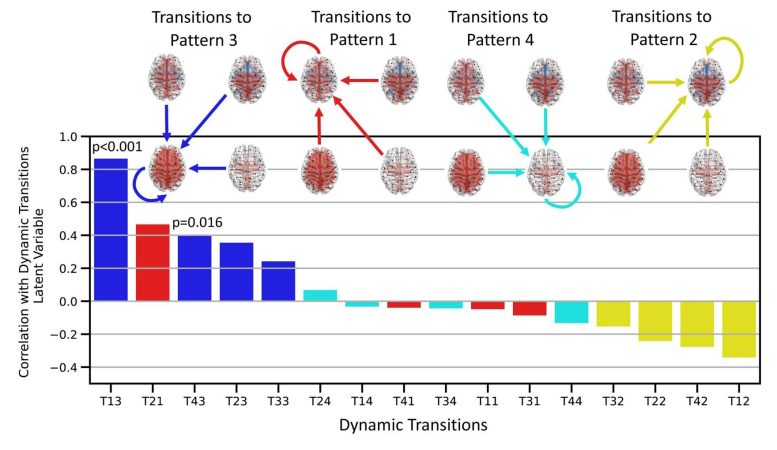Psilocybin’s Hyperconnected Brain State Linked to Therapeutic Effects


A new study reveals that psilocybin, found in “magic mushrooms,” induces a dynamic state of brain hyperconnectivity associated with the sensation of oceanic boundlessness and ego-altering experiences. These findings could improve the therapeutic use of psychedelics in treating mental health disorders such as depression. Credit: SciTechDaily
Study shows psilocybin induces dynamic brain connectivity, linked to profound, ego-altering experiences, potentially beneficial in psychotherapy.
Researchers from Elsevier have discovered that psilocybin, the active compound in “magic mushrooms,” creates a state of hyperconnectivity in the brain. The state is associated with ego-modifying effects and a sensation known as oceanic boundlessness, which encompasses feelings of unity, bliss, insight, and spiritual experiences typically reported during psychedelic experiences. Their findings, published in Biological Psychiatry: Cognitive Neuroscience and Neuroimaging, help explain the mystical experiences reported during psychedelic use and offer insights into its therapeutic potential for the treatment of mental health disorders.
Dynamic Brain Connectivity
Researchers utilized brain imaging to discover a specific association between the experiential, psychedelic state and whole-brain dynamic connectivity changes. While previous research has shown increases in static global brain connectivity under psychedelics, the current study shows that this state of hyperconnectivity is dynamic, and its transition rate coincides with the feeling of oceanic boundlessness, a hallmark dimension of the psychedelic state.
“Psilocybin has been one of the most studied psychedelics, possibly due to its potential contribution in treating different disorders, such as obsessive-compulsive disorder, death-related anxiety, depression, treatment-resistant depression, major depressive disorder, terminal cancer-associated anxiety, demoralization, smoking, and alcohol and tobacco addiction. What was not fully understood is what brain activity is associated with these profound experiences,” explained lead researcher Johannes G. Ramaekers, PhD, Department of Neuropsychology and Psychopharmacology, Faculty of Psychology and Neuroscience, Maastricht University.

A new study finds a pattern of psilocybin-induced dynamic hyperconnectivity in the brain, which is linked to oceanic boundlessness. Credit: Biological Psychiatry: Cognitive Neuroscience and Neuroimaging
Psilocybin generates profound alterations both at the brain and the experiential level. The brain’s tendency to enter a hyperconnected-hyperarousal pattern under psilocybin represents the potential to entertain variant mental perspectives. The findings of the new study illuminate the intricate interplay between brain dynamics and subjective experience under psilocybin, providing insights into the neurophysiology and neuro-experiential qualities of the psychedelic state.
Ramaekers adds, “Taken together, averaged and dynamic connectivity analyses suggest that psilocybin alters brain function such that the overall neurobiological pattern becomes functionally more connected, more fluid, and less modular.”
Insights From fMRI Studies
Previously acquired functional magnetic resonance imaging (fMRI) data were analyzed for two groups of people; one group of 22 individuals received a single dose of psilocybin, the other 27 participants received a placebo. During the drug’s peak effects, participants who received psilocybin reported substantial phenomenological changes compared to placebo. Also, brain connectivity analysis showed that a pattern characterized by global region-to-region connectivity was re-appearing across the acquisition time in the psilocybin group, potentially accounting for the variant mental associations that participants experience.
Moreover, this hyperconnected pattern was linked to oceanic boundlessness and unity, which indicates an important mapping between brain dynamics and subjective experience, pointing towards “egotropic effects” (vs hallucinogenic) of the drug.
PhD candidate and co-author of the paper Larry Fort, University of Liège, emphasizes: “Psychedelic drugs like psilocybin are often referred to as hallucinogens both scientifically and colloquially. As such, we expected that the hallucinatory dimensions of experience would correlate the highest with psilocybin’s hyperconnected pattern. However, hallucinatory experience had a strong, but weaker correlation with this pattern than ego-modifying experiences. This led us to formulate the term ‘egotropic’ to draw attention to these ego-modifying effects as important, perhaps even more so than their hallucinogenic counterparts.”
Implications and Future Directions
“This study uses readily available resting state fMRI images acquired after psilocybin ingestion to provide new insights into the neurophysiological mechanisms underlying the subjective and clinical effects of the drug. It sets the stage for future studies using other psychedelic agents to examine whether the dynamic connectivity effects reflect a general mechanism for the therapeutic effects of these compounds,” said Editor-in-Chief of Biological Psychiatry: Cognitive Neuroscience and Neuroimaging Cameron S. Carter, MD, University of California Irvine.
Lead investigator Athena Demertzi, PhD, Physiology of Cognition, GIGA-CRC In Vivo Imaging Center, University of Liège, adds, “We were pleasantly surprised to learn that the brain pattern of hyperconnected regions was further characterized by lower global signal amplitude, which works as a proxy to heightened cortical arousal. So far, this is the first time that such approximation of arousal levels using fMRI was attempted in psychedelic research. This might be an important correlation as we move towards a full characterization of brain states under psychedelics.”
She concludes, “Given the resurgence in research regarding the psychotherapeutic applications of psychedelic drugs, our results are pertinent to understanding how subjective experience under psychedelics influences beneficial clinical outcomes. Is the effect driven by ego-dissolution? By hallucinations? As such, our work exemplifies how the strong inter-relatedness between egotropic effects of moderate dose psilocybin and its hyperconnected brain pattern can inform clinical focus on specific aspects of phenomenology, such as ego-dissolutions. With this information, healthcare professionals may learn how to best engineer psychedelic therapy sessions to produce the best clinical outcomes.”
Reference: “Dynamic Functional Hyperconnectivity after Psilocybin Intake is Primarily Associated with Oceanic Boundlessness” by Sepehr Mortaheb, Larry D. Fort, Natasha L. Mason, Pablo Mallaroni, Johannes G. Ramaekers and Athena Demertzi, 6 April 2024, Biological Psychiatry: Cognitive Neuroscience and Neuroimaging.
DOI: 10.1016/j.bpsc.2024.04.001


